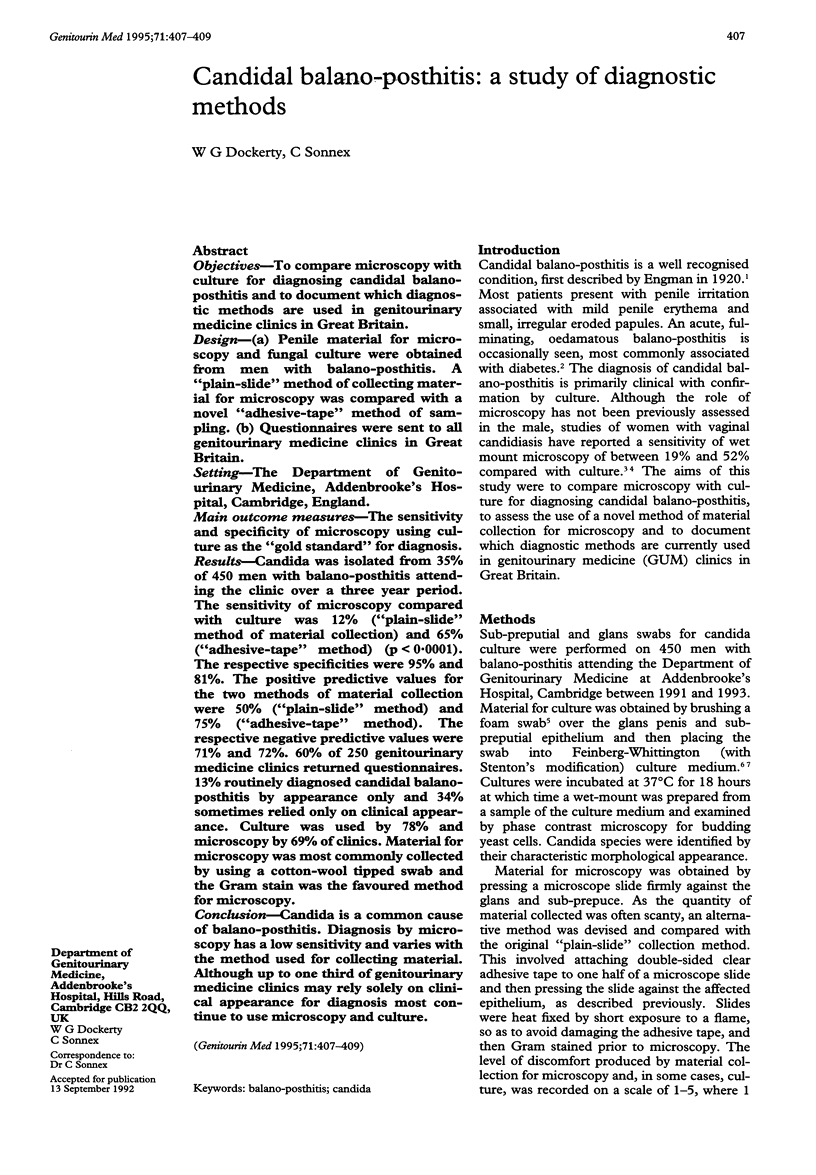Abstract
OBJECTIVES--To compare microscopy with culture for diagnosing candidal balanoposthitis and to document which diagnostic methods are used in genitourinary medicine clinics in Great Britain. DESIGN--(a) Penile material for microscopy and fungal culture were obtained from men with balano-posthitis. A "plain-slide" method of collecting material for microscopy was compared with a novel "adhesive-tape" method of sampling. (b) Questionnaires were sent to all genitourinary medicine clinics in Great Britain. SETTING--The Department of Genitourinary Medicine, Addenbrooke's Hospital, Cambridge, England. MAIN OUTCOME MEASURES--The sensitivity and specificity of microscopy using culture as the "gold standard" for diagnosis. RESULTS--Candida was isolated from 35% of 450 men with balano-posthitis attending the clinic over a three year period. The sensitivity of microscopy compared with culture was 12% ("plain-slide" method of material collection) and 65% ("adhesive-tape" method) (p < 0.0001). The respective specificities were 95% and 81%. The positive predictive values for the two methods of material collection were 50% ("plain-slide" method) and 75% ("adhesive-tape" method). The respective negative predictive values were 71% and 72%. 60% of 250 genitourinary medicine clinics returned questionnaires. 13% routinely diagnosed candidal balanoposthitis by appearance only and 34% sometimes relied only on clinical appearance. Culture was used by 78% and microscopy by 69% of clinics. Material for microscopy was most commonly collected by using a cotton-wool tipped swab and the Gram stain was the favoured method for microscopy. CONCLUSION--Candida is a common cause of balano-posthitis. Diagnosis by microscopy has a low sensitivity and varies with the method used for collecting material. Although up to one third of genitourinary medicine clinics may rely solely on clinical appearance for diagnosis most continue to use microscopy and culture.
Full text
PDF


Selected References
These references are in PubMed. This may not be the complete list of references from this article.
- Bergman J. J., Berg A. O., Schneeweiss R., Heidrich F. E. Clinical comparison of microscopic and culture techniques in the diagnosis of Candida vaginitis. J Fam Pract. 1984 Apr;18(4):549–552. [PubMed] [Google Scholar]
- Birley H. D., Walker M. M., Luzzi G. A., Bell R., Taylor-Robinson D., Byrne M., Renton A. M. Clinical features and management of recurrent balanitis; association with atopy and genital washing. Genitourin Med. 1993 Oct;69(5):400–403. doi: 10.1136/sti.69.5.400. [DOI] [PMC free article] [PubMed] [Google Scholar]
- Eddie D. A. The laboratory diagnosis of vaginal infections caused by Trichomonas and Candida (Monilia) species. J Med Microbiol. 1968 Aug;1(1):153–159. doi: 10.1099/00222615-1-1-153. [DOI] [PubMed] [Google Scholar]
- Fornasa C. V., Calabro A., Miglietta A., Tarantello M., Biasinutto C., Peserico A. Mild balanoposthitis. Genitourin Med. 1994 Oct;70(5):345–346. doi: 10.1136/sti.70.5.345. [DOI] [PMC free article] [PubMed] [Google Scholar]
- Hillman R. J., Walker M. M., Harris J. R., Taylor-Robinson D. Penile dermatoses: a clinical and histopathological study. Genitourin Med. 1992 Jun;68(3):166–169. doi: 10.1136/sti.68.3.166. [DOI] [PMC free article] [PubMed] [Google Scholar]
- STENTON P. The isolation of Trichomonas vaginalis. J Med Lab Technol. 1957 Oct;14(4):228–230. [PubMed] [Google Scholar]
- Waugh M. A., Evans E. G., Nayyar K. C., Fong R. Clotrimazole (Canesten) in the treatment of candidal balanitis in men. With incidental observations on diabetic candidal balanoposthitis. Br J Vener Dis. 1978 Jun;54(3):184–186. doi: 10.1136/sti.54.3.184. [DOI] [PMC free article] [PubMed] [Google Scholar]


